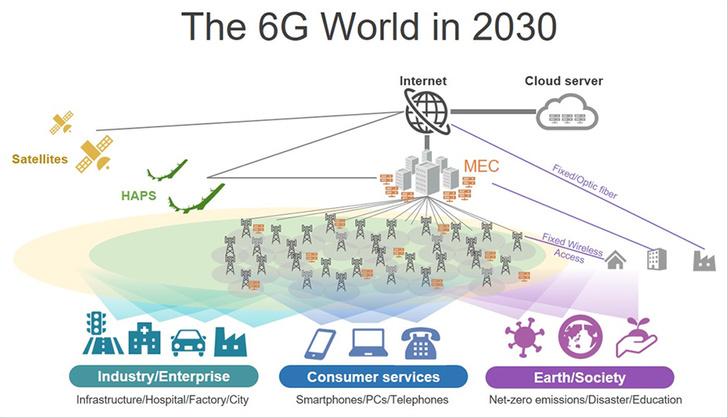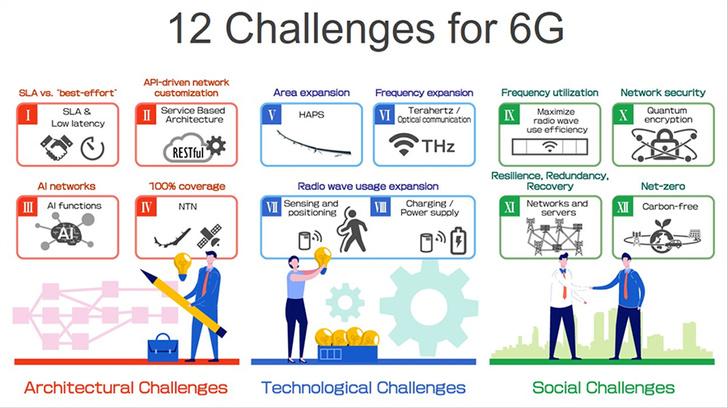SoftBank Corp. (“SoftBank”) announced its 6G (known as “Beyond 5G” in Japan) concept, as well as the challenges that need to be overcome to make the concept a reality.
On top of enhancing 5G's features that include ultra-high-speeds, ultra-low latency, and massive device connectivity, 6G is expected to bring new technological innovations, including high reliability and improved energy efficiency. To provide a network infrastructure needed for the 6G era society, SoftBank is taking up the challenge of resolving numerous issues in different areas. Working toward that goal, SoftBank's current initiatives include expanding into areas where wireless technologies can be utilized for purposes other than telecommunications such as, evolving network architectures where AI can function, ensuring high levels of resiliency so that all businesses can utilize these advancements with peace of mind, and contributing to the realization of a carbon-free society.
Ryuji Wakikawa, SoftBank Corp. Vice President and Head of the Advanced Technology Division, commented as follows:
- -Up to 4G, mobile networks were designed for smartphone usage. After 5G, the advent of 6G will transform mobile networks into network infrastructure that will support the digitalization of all industries. With 6G, every business across Japan will be built on the foundation of mobile networks, just as the Internet became the sole common basic infrastructure for online communications around the world.
- -The Internet will be utilized to build a virtual digital space, with mobile networks connecting base stations and devices. In this way, digital and physical spaces will be connected in real time. What is predicted and judged in the virtual space using AI will be fed back to the physical space with ultra-low latency. Not only will 6G networks serve as communication networks; they will also evolve into computers that support an AI society. Edge computers will be deployed everywhere in Japan, and these computers will be capable of AI and other types of server processing to disperse computing. These computers will establish a high-quality, end-to-end communications environment connected to networks in highly sophisticated ways. If AI is the trigger for the next Industrial Revolution, 6G will be the telecommunications infrastructure that makes it happen.
- -SoftBank started research and development of potential 6G technologies such as High Altitude Platform Stations (HAPS) and terahertz communication back in 2017. By flying base stations in the stratosphere, HAPS systems are capable of receiving and transmitting radio waves over an area stretching as far as 200km in diameter, as well as into the airspace above. As such, HAPS is expected to be a key technology for expanding communication area coverage. We have already successfully completed a communications test in the stratosphere, spearheaded initiatives to standardize HAPS frequency bands, established a global industry alliance, among other achievements. Furthermore, as part of our efforts to expand frequency usage, we are working on the terahertz range beyond millimeter-wave with the aim of applying these frequencies for telecommunications. New possibilities will open for wireless networks to be used at data centers, such as wireless communications between racks and servers, when we achieve telecommunications faster than fiber-optic cables and reach communication speeds in excess of several hundreds of gigabytes per second.
- -We have been working on various research and development projects, always taking the application of mobile communications into consideration while doing so. We are now unveiling some of these technologies for the first time. 6G is playing a key role in SoftBank's digital platform strategy, and it will support a variety of businesses as a common basic infrastructure, help AI technologies to blossom through the creation of “digital twins,” and make it possible to realize fully customizable communications networks and computer resources. Guided by our corporate philosophy, “Information Revolution – Happiness for everyone,” SoftBank is taking on the challenges to make 6G a reality with the aim of realizing the complete digitalization in Japan.


SoftBank also unveiled two initiatives as specific examples of its undertakings to realize 6G services.
This first one is an R&D project involving “Moving Terahertz” for smartphones. This initiative focuses on expanding frequency ranges that will enable SoftBank to provide commercial services using the terahertz band for mobile communications. The exhibit introduces a system based on the concept of moving terahertz, publicly demonstrating its application via real-time video transmission utilizing OFDM*2 in a mobile communications system.
The second involves SoftBank's initiatives to establish HAPS technologies, where communications equipment (a payload) that was used in a stratospheric flight test is displayed. Also on display is a cylinder antenna currently under development and a demonstration of rotating connector technology. Both technologies are essential for realizing footprint fixation technologies to control communications areas, which will be necessary to provide stable communication services with HAPS.
